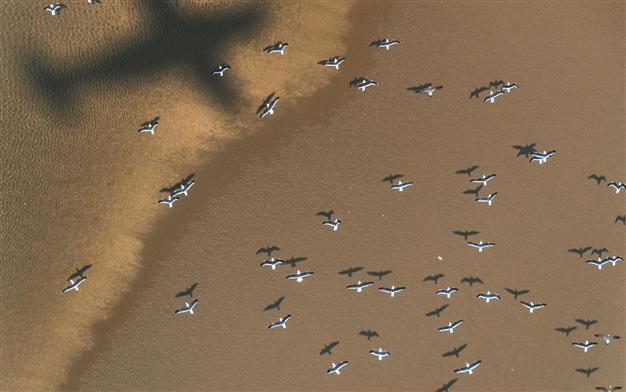Istanbul’s third airport threatens birds’ migration routes
Elif İnce ISTANBUL

Some 600,000 birds fly each year in spring and autumn over the area where the third Istanbul airport is being built, according to Arslangündoğdu. CORBİS Photo
Istanbul’s third airport is located along one of the most important migration routes for birds, experts say, warning that its construction poses dangers not only to the environment, but even flights.Zeynel Arslangündoğdu, an expert of ornithology at Istanbul University, told Radikal that the northern forests in Istanbul’s European side are among the main corridors used by migrating birds crossing the metropolis.
The controversial facility, promoted by the government to showcase development, will become not only Istanbul’s largest airport but also one of the world’s major hubs. Its construction in one of the city’s most precious natural areas, however, has drawn criticism from activists denouncing a culture of plunder and destruction.
The airport will not only inflict a heavy toll on the living creatures in the affected forests, but may also hold a large impact for birds, Arslangündoğdu said.
Some 600,000 birds fly each year in spring and autumn over the area where the airport is being built, including rare species under protection by the Bern Convention on the Conservation of European Wildlife and Natural Habitats, to which Turkey is a party, according to Arslangündoğdu.
“Turkey is richer than many European countries in terms of bird species. There are some 470 species across the country. In the area affected by the third airport and the roads connecting to it … we are talking about 200 species. In other words, half of the species in Turkey live there,” he said, adding that migratory birds include rare raptors such as rarely spotted eagles.
Risk of 'two or three serious accidents'
Arslangündoğdu criticized the current environmental impact assessment report (ÇED) submitted by the construction companies, describing it as “patchy and insufficient.”
“There is not only missing information, but also some of it is false,” he said. “The number of species that can likely be found in the area has been limited to 17. The list was apparently taken randomly from a book on birds. For example, the black-backed gull, which figures in the list, is not a common species in the country. On the other hand, many other species of gulls that are common doesn’t even figure in the list,” he said.
Arslangündoğdu added that two years of observation are necessary to make a proper assessment regarding bird migration in the area. Now that construction has started, however, it is already too late.
He also noted that birds could pose risks to planes and passengers, stressing that the number of birds crossing the new airport and the subsequent risk will be much higher than at Istanbul’s main Atatürk airport.
“If there are 50,000 to 100,000 birds crossing the Atatürk airport in autumn, we can say that 400,000 birds will cross above the third airport in spring,” he said, sounding the alarm that this would create a “Hitchcockian scenario” for passing planes, referring to British director Alfred Hitchcock’s classic 1963 horror film “The Birds.”
Arslangündoğdu has used modeling methods to demonstrate the flight safety risks related to migratory birds. Using reports of a landing or takeoff every three minutes as stated in the environmental impact assessment report, and applying only morning flights, he calculated a risk of two or three serious accidents each year. “If we also count smaller accidents, the number climbs well over 10,” he said.
He also emphasized that the migratory routes of birds would not be able to adapt to the flights from the new airport. “This is something that has developed over tens of thousands years. Experienced birds know the routes and orientate the flock,” he said.
The Northern Forest Defense, an environmental group that has been long advocating against the third airport and bridge, has launched an online campaign under the hashtag “Resist the third airport.”
However, the 22.1 billion euro mega-project, won by a consortium of five companies known for their ties to the ruling Justice and Development Party (AKP) and marred by graft claims, has been met with the government’s blessing. The new airport is expected to host 150 million passengers each year.
















